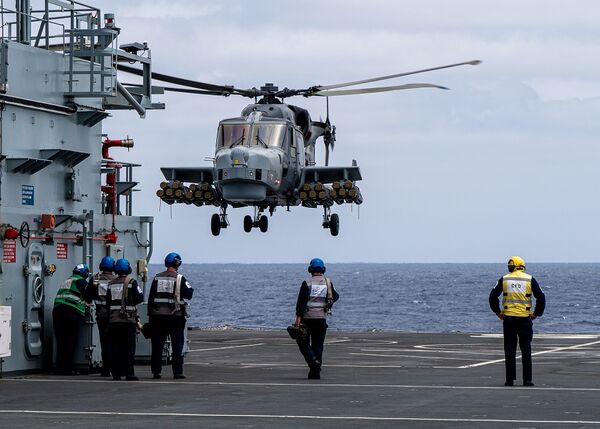
A Royal Navy Wildcat helicopter seen carrying a maximum loadout of 20 Martlet missiles during recent trials of the new weapons wing. (Crown copyright)
The Royal Navy (RN) has completed trials of a new weapons-carriage wing for the Leonardo AW159 Lynx Wildcat HMA2 helicopter.
Defence Equipment & Support (DE&S) announced the milestone on 12 October, saying that the naval variant of the Wildcat helicopter had successfully proven the concept of the weapons wing during recent sea trials.
“Successful Ship Helicopter Operating Limitations (SHOL) trials have proven that the Wildcat HMA2 can operate fully loaded with its newest missile systems in a range of challenging conditions at sea,” DE&S said. “Operating from RFA Argus in the Atlantic and Mediterranean over a month, a specially instrumented Wildcat HMA was flown on 19 days for a total of 87 hours and conducted 894 deck take-offs and landings, by day and night.”
Seven weapons configurations were successfully tested, including missiles under both weapon wings and one at a time, while various approach and departure paths from the ship were tested in challenging conditions to see how the Wildcat would handle. “The Wildcat handled them all,” DE&S said.
The trials, which saw the Wildcat carry both the short-range Thales Martlet and longer-range MBDA Sea Venom variants of the Future Anti-Surface Guided Weapon (FASGW), were conducted by DE&S and the Wildcat Force in partnership with QinetiQ and the Air Test & Evaluation Centre.
“Once analysed, the data from the SHOL trials will guide air and ground crew as they operate FASGW-armed Wildcat from frigates, destroyers, auxiliaries, and the Queen Elizabeth-class aircraft carriers,” the DE&S said.
Looking to read the full article?
Gain unlimited access to Janes news and more...







